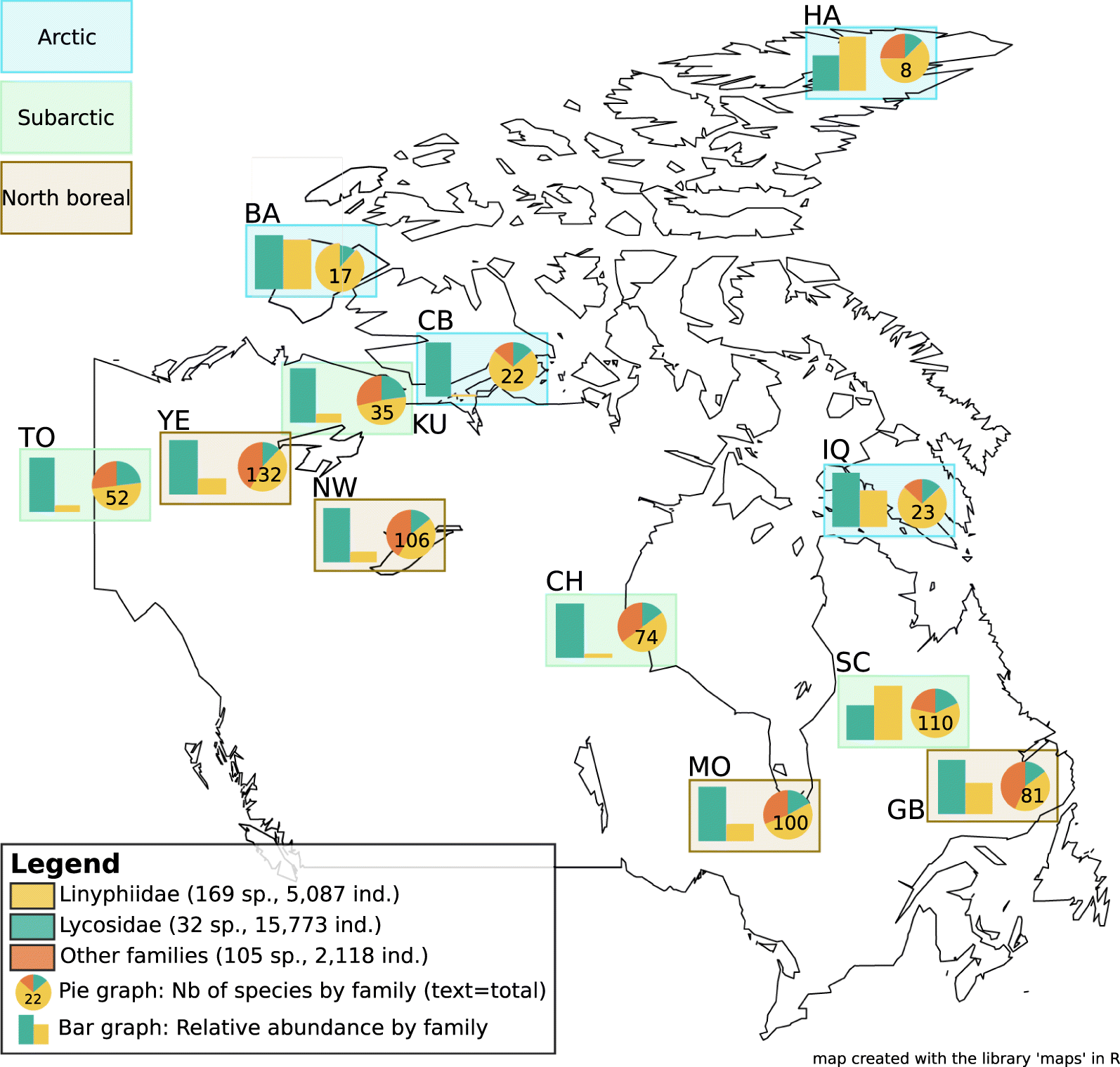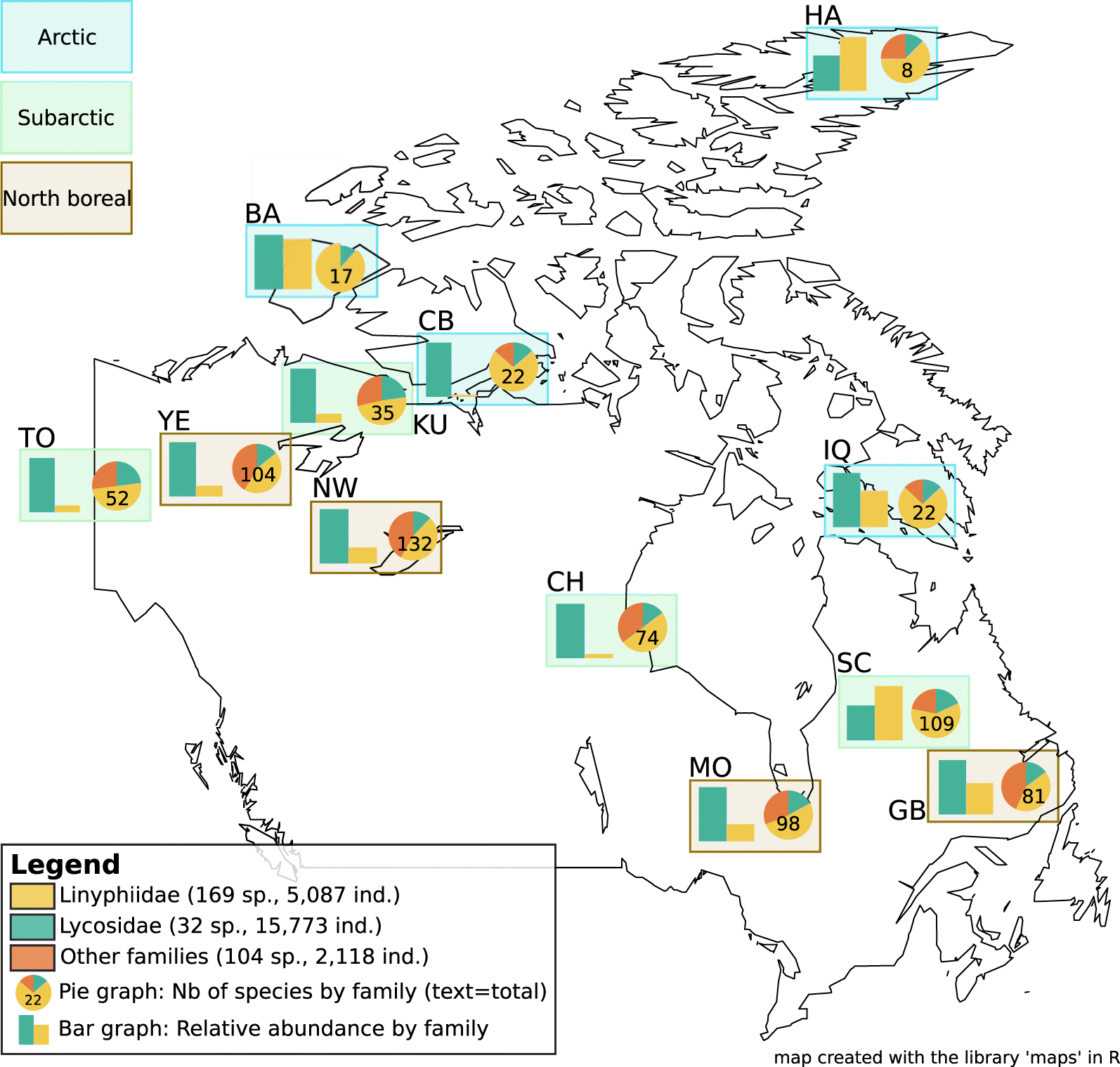Correction: Small- to large-scale patterns of ground-dwelling spider (Araneae) diversity across northern Canada
| Arctic | Subarctic | North boreal | |||||||||||
|---|---|---|---|---|---|---|---|---|---|---|---|---|---|
| Hazen | Iqaluit | Cambridge Bay | Banks Island | Churchill | Schefferville | Tombstone | Kugluktuk | Goose Bay | Moosonee | Yellowknife | Norman Wells | Total | |
| Observed total richness | 8 | 22 | 21 | 16 | 74 | 109 | 52 | 35 | 81 | 98 | 104 | 132 | 305 |
| Jackknife 1 | 8 ± 0 | 31 ± 3 | 27 ± 2 | 20 ± 2 | 105 ± 6 | 146 ± 7 | 75 ± 6 | 41 ± 3 | 117 ± 7 | 139 ± 9 | 132 ± 6 | 173 ± 7 | — |
| Chao 1 | 8 ± 0 | 34 ± 10 | 28 ± 8 | 19 ± 3 | 127 ± 27 | 152 ± 19 | 119 ± 44 | 41 ± 7 | 174 ± 48 | 191 ± 44 | 129 ± 12 | 181 ± 21 | — |
| Completeness (%) | 100 | 74 | 82 | 85 | 71 | 16 | 70 | 85 | 69 | 71 | 80 | 76 | — |
| Number of singletons | 0 | 5 | 5 | 3 | 25 | 29 | 20 | 6 | 34 | 38 | 23 | 39 | 68 |
| Number of genera | 8 | 16 | 17 | 13 | 43 | 49 | 29 | 22 | 51 | 55 | 58 | 66 | 111 |
| Number of families | 4 | 4 | 5 | 2 | 8 | 12 | 8 | 6 | 14 | 14 | 12 | 13 | 14 |
| Number of mature individuals | 1088 | 384 | 3509 | 1383 | 2478 | 2123 | 1354 | 2326 | 1557 | 2228 | 2311 | 2274 | 23015 |
| % of immature individuals | 48 | 67 | 10 | 26 | 19 | 13 | 20 | 13 | 15 | 13 | 13 | 14 | 19 |
| Number of active trapping days | 9 | 12 | 12 | 12 | 12 | 9 | 10 | 10 | 9 | 10 | 11 | 10 | 126 |
Note: Completeness = (observed species richness)/(Jackknife 1) × 100.

| Arctic | Subarctic | North boreal | |||||||||||
|---|---|---|---|---|---|---|---|---|---|---|---|---|---|
| Hazen | Iqaluit | Cambridge Bay | Banks Island | Churchill | Schefferville | Tombstone | Kugluktuk | Goose Bay | Moosonee | Yellowknife | Norman Wells | Total | |
| Observed total richness | 8 | 22 | 22 | 17 | 74 | 109 | 52 | 35 | 81 | 98 | 104 | 132 | 305 |
| Jackknife 1 | 8 ± 0 | 31 ± 3 | 27 ± 2 | 20 ± 2 | 105 ± 6 | 146 ± 7 | 75 ± 6 | 41 ± 3 | 117 ± 7 | 139 ± 9 | 132 ± 6 | 173 ± 7 | — |
| Chao 1 | 8 ± 0 | 34 ± 10 | 28 ± 8 | 19 ± 3 | 127 ± 27 | 152 ± 19 | 119 ± 44 | 41 ± 7 | 174 ± 48 | 191 ± 44 | 129 ± 12 | 181 ± 21 | — |
| Completeness (%) | 100 | 74 | 82 | 85 | 71 | 16 | 70 | 85 | 69 | 71 | 80 | 76 | — |
| Number of singletons | 0 | 5 | 5 | 3 | 25 | 29 | 20 | 6 | 34 | 38 | 23 | 39 | 68 |
| Number of genera | 8 | 16 | 17 | 13 | 43 | 49 | 29 | 22 | 51 | 55 | 58 | 66 | 111 |
| Number of families | 4 | 4 | 5 | 2 | 8 | 12 | 8 | 6 | 14 | 14 | 12 | 13 | 14 |
| Number of mature individuals | 1088 | 383 | 3509 | 1383 | 2479 | 2123 | 1354 | 2326 | 1556 | 2225 | 2310 | 2274 | 23010 |
| % of immature individuals | 48 | 67 | 10 | 26 | 19 | 13 | 20 | 13 | 15 | 13 | 13 | 14 | 19 |
| Number of active trapping days | 9 | 12 | 12 | 12 | 12 | 9 | 10 | 10 | 9 | 10 | 11 | 10 | 126 |
Note: Completeness = (observed species richness)/(Jackknife 1) × 100.

Information & Authors
Information
Published In

History
Copyright
Sections
Subjects
Authors
Metrics & Citations
Metrics
Other Metrics
Citations
Cite As
Export Citations
If you have the appropriate software installed, you can download article citation data to the citation manager of your choice. Simply select your manager software from the list below and click Download.
